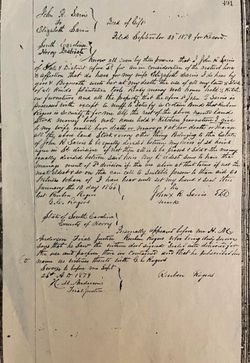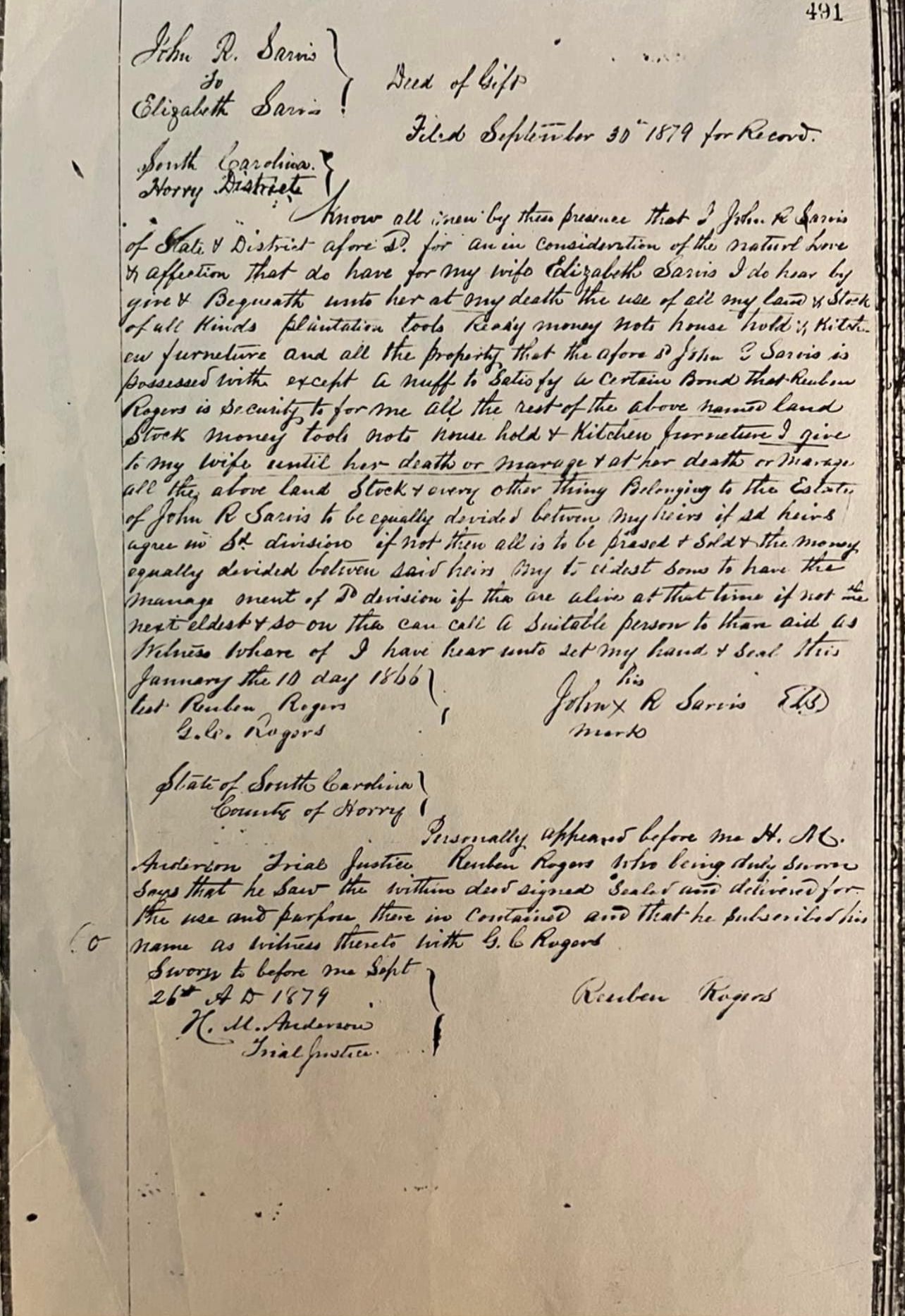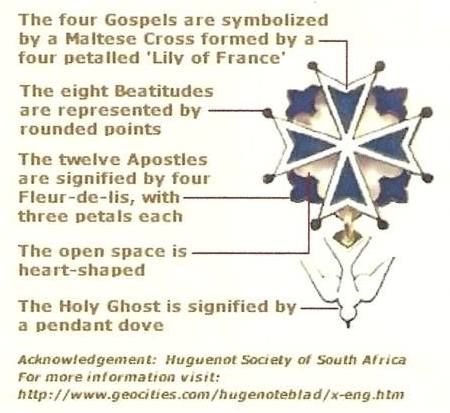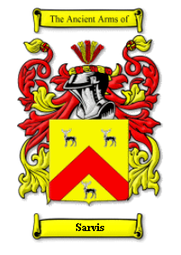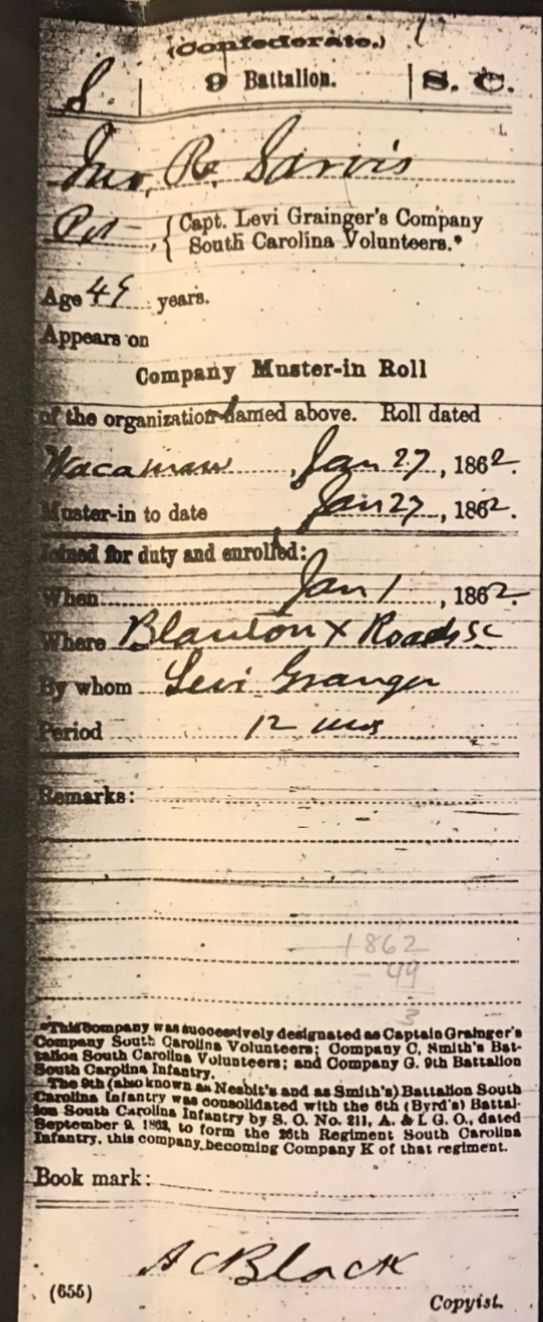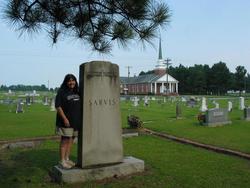John Reynolds Sarvis was a Confederate veteran who served in the 9th South Carolina Infantry Battalion (the "Pee Dee Legion"), Company G. He volunteered in January of 1862, the same day as his sons Thomas Lester Sarvis and William Scarborough Sarvis who served with their father in Company G. (William died during the war in 1862.) John's unit was later merged with the 26th South Carolina Volunteers. The 26th saw action in South Carolina, Mississippi, and Virginia.
John was a farmer who donated the land for Pleasant Meadow Baptist Church in Loris, Horry County. He was 67 when he died on September 29, 1879 in Horry County and is probably buried in that church's cemetery in an unmarked grave. His cause of death is listed as "a fever."
Sarvis is a surname often, but not always, associated with coastal Carolina Native Americans. So, John may, or may not, have had American Indian heritage. In fact in this case, the Sarvis surname may have originally been Serivens, a French Huguenot name. John did also have English heritage.
If the Sarvis family has any Native American ancestry, there are a variety of reasons Native American (American Indian) ancestry may not show up in a person's DNA. One obvious reason is that a person may never have had any Native American ancestors. There are, however, other reasons. For most Americans with Native American ancestors, that ancestry is five or more generations back. In fact it can be so far back in a family tree that it does not show up in DNA tests. Also, most ancestry testing companies use only a small sample of Native American groups (often less than half a dozen tribes) as a reference for testing, and many of those sample groups are from South, rather than North, America. (My own case is a good example of how inaccurate genetics testing companies can be when it comes to Native American ancestry. Three different companies have estimated my Indian ancestry as none, a trace, and 9%.). Another important point about American Indian (Native American) DNA ancestry should be made. Anthropologist Mary Helms created the term "colonial Indian tribes" in the 1960s to refer to societies which originated as recognizable entities only as a direct result of colonial policies. Colonial tribes are often a racially mixed people that over time became identified more with their Indian ancestry rather than their African or white ancestry. These groups are culturally Indian while ultimately having little, if any, Indian DNA. Colonial tribes include groups as diverse as the Miskito Indians of eastern Nicaragua (whom Helms studied); various Amazon tribes in Brazil; the Lumbee Indians of North Carolina; the Black Seminoles of Oklahoma, Mexico, and the Bahamas; and many others. The term colonial tribe attempts to get at the idea that someone can be culturally something (American Indian, for example) without being biologically something. So, it should not be surprising that someone with, for example, a Lumbee Indian ancestor would not necessarily test as having significant American Indian DNA.
Fellow Sarvis descendant and my fourth cousin, Johnny Otto Sarvis, Jr., is certain the Sarvis family has no Native American ancestry and writes, "Anyone can look at Sarvises and see they don't have NA [Native American] in them and as far as that book you quote well many books have been written that does not even know what they're writing about and are not up on the subject matter (ie Sarvis) it's just some educational hypothesis!"
I hope one of John Reynolds Sarvis' descendants will add his photo to this site. Thanks so much to descendants Kay Evans, Wanda V., Johnny Otto Sarvis, Jr., and "Anonymous" for so much of this information. Any errors, however, are mine alone. Please go to the "edit" link on this site with any corrections or additions.
John Reynolds Sarvis was a Confederate veteran who served in the 9th South Carolina Infantry Battalion (the "Pee Dee Legion"), Company G. He volunteered in January of 1862, the same day as his sons Thomas Lester Sarvis and William Scarborough Sarvis who served with their father in Company G. (William died during the war in 1862.) John's unit was later merged with the 26th South Carolina Volunteers. The 26th saw action in South Carolina, Mississippi, and Virginia.
John was a farmer who donated the land for Pleasant Meadow Baptist Church in Loris, Horry County. He was 67 when he died on September 29, 1879 in Horry County and is probably buried in that church's cemetery in an unmarked grave. His cause of death is listed as "a fever."
Sarvis is a surname often, but not always, associated with coastal Carolina Native Americans. So, John may, or may not, have had American Indian heritage. In fact in this case, the Sarvis surname may have originally been Serivens, a French Huguenot name. John did also have English heritage.
If the Sarvis family has any Native American ancestry, there are a variety of reasons Native American (American Indian) ancestry may not show up in a person's DNA. One obvious reason is that a person may never have had any Native American ancestors. There are, however, other reasons. For most Americans with Native American ancestors, that ancestry is five or more generations back. In fact it can be so far back in a family tree that it does not show up in DNA tests. Also, most ancestry testing companies use only a small sample of Native American groups (often less than half a dozen tribes) as a reference for testing, and many of those sample groups are from South, rather than North, America. (My own case is a good example of how inaccurate genetics testing companies can be when it comes to Native American ancestry. Three different companies have estimated my Indian ancestry as none, a trace, and 9%.). Another important point about American Indian (Native American) DNA ancestry should be made. Anthropologist Mary Helms created the term "colonial Indian tribes" in the 1960s to refer to societies which originated as recognizable entities only as a direct result of colonial policies. Colonial tribes are often a racially mixed people that over time became identified more with their Indian ancestry rather than their African or white ancestry. These groups are culturally Indian while ultimately having little, if any, Indian DNA. Colonial tribes include groups as diverse as the Miskito Indians of eastern Nicaragua (whom Helms studied); various Amazon tribes in Brazil; the Lumbee Indians of North Carolina; the Black Seminoles of Oklahoma, Mexico, and the Bahamas; and many others. The term colonial tribe attempts to get at the idea that someone can be culturally something (American Indian, for example) without being biologically something. So, it should not be surprising that someone with, for example, a Lumbee Indian ancestor would not necessarily test as having significant American Indian DNA.
Fellow Sarvis descendant and my fourth cousin, Johnny Otto Sarvis, Jr., is certain the Sarvis family has no Native American ancestry and writes, "Anyone can look at Sarvises and see they don't have NA [Native American] in them and as far as that book you quote well many books have been written that does not even know what they're writing about and are not up on the subject matter (ie Sarvis) it's just some educational hypothesis!"
I hope one of John Reynolds Sarvis' descendants will add his photo to this site. Thanks so much to descendants Kay Evans, Wanda V., Johnny Otto Sarvis, Jr., and "Anonymous" for so much of this information. Any errors, however, are mine alone. Please go to the "edit" link on this site with any corrections or additions.
Family Members
-
![]()
PVT Thomas Lester "Tommy" Sarvis
1847–1931
-
![]()
PVT William Scarborough Sarvis
1848–1862
-
![]()
George Marsden Sarvis
1850–1871
-
![]()
Edward Charles "Ned" Sarvis
1851–1927
-
![]()
Helan Sarvis King
1852–1918
-
![]()
Sharlotte Ada Sarvis Neely
1853 – unknown
-
![]()
Rhoda Mary Elizabeth "Lizzie" Sarvis Cartrette
1854–1934
-
![]()
Eahmon A. Sarvis
1858–1871
-
![]()
Bowden Sarvis
1859–1871
-
![]()
Dock J Sarvis
1861–1931
-
![]()
James Scarborough Sarvis
1862–1919
